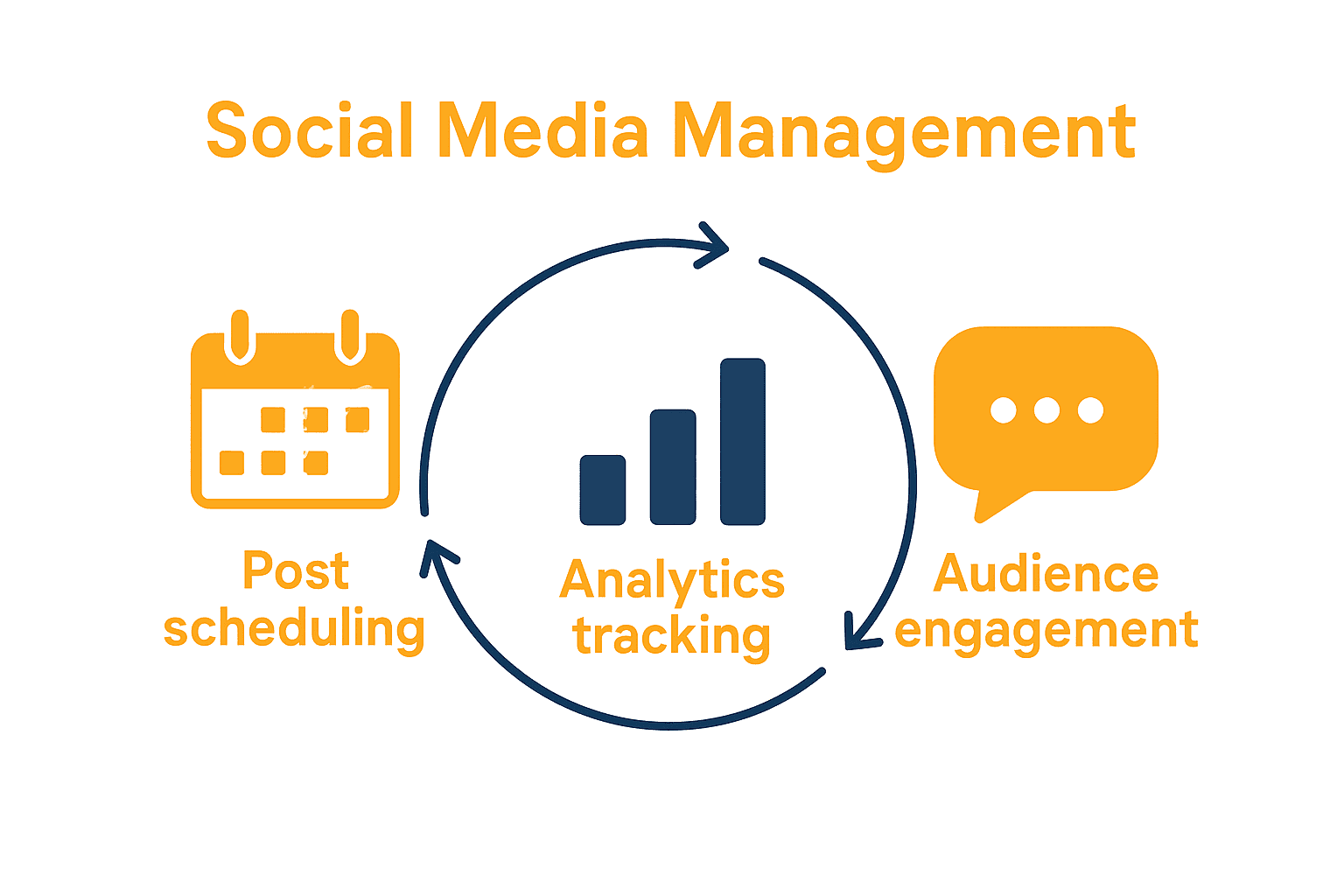Creating a Social Media Plan for Regional Business Success
- Eddie The Chef

- 11 minutes ago
- 7 min read

More than 65 percent of australian small businesses now use social media to connect with customers and grow their brand. Making sense of all the available platforms, tools, and tactics can seem daunting if you want your efforts to actually pay off. Getting the fundamentals right helps australian businesses stand out, reach the right people, and build real engagement. This step-by-step guide breaks down proven strategies so you can create a social media presence that drives results and helps your business thrive.
Table of Contents
Quick Summary
Key Point | Explanation |
1. Define measurable business goals | Establish clear and measurable objectives that align with your overall business strategy to guide your social media efforts effectively. |
2. Identify your target audience | Create a detailed audience persona that includes demographics and behaviours to ensure your content resonates with the right people. |
3. Choose appropriate social platforms | Focus on two or three social media platforms where your audience is most active to maximise engagement and resource efficiency. |
4. Develop a structured content plan | Identify 3-5 core themes and use a content calendar to schedule posts for consistent and engaging messaging. |
5. Regularly measure and refine strategy | Track key performance indicators and conduct quarterly reviews to adapt your social media strategy based on audience engagement insights. |
Step 1: Assess your business goals and audience
Crafting a robust social media strategy starts with understanding exactly what your regional business wants to achieve and who you’re speaking to. According to research from vuir, successful social media adoption for Australian small businesses hinges on carefully aligning digital communication with specific business objectives.
Begin by defining clear measurable goals that directly connect to your broader business strategy. Are you aiming to increase brand awareness? Generate leads? Drive website traffic? Each goal requires a tailored approach. For instance, if your primary objective is lead generation, you’ll want to create content that encourages potential customers to take action. Next, develop a detailed profile of your target audience by considering demographics like age, location, interests, and online behaviours. The gleneira resource emphasises that understanding audience characteristics helps you select the most appropriate social media platforms for your marketing efforts.
A practical tip is to create a simple audience persona document that outlines key characteristics, pain points, and communication preferences. This living document will guide your content creation and help you speak directly to the people most likely to engage with your business. By taking time to thoroughly assess your goals and audience upfront, you’re setting the foundation for a social media plan that can genuinely drive business growth.
Step 2: Select the right social platforms for your niche
Narrowing down the most effective social media platforms for your regional business requires strategic thinking and careful analysis. According to gleneira, different social platforms offer unique characteristics that suit various business types and target audiences.
Start by matching your target audience demographics with platform usage patterns. Instagram and TikTok work brilliantly for businesses targeting younger audiences, while Facebook remains strong for reaching older demographic groups. LinkedIn proves ideal for professional services and B2B companies. Consider the content types your business can consistently produce photography heavy businesses will shine on visual platforms like Instagram while professional consultants might prefer LinkedIn’s more formal environment. How to Market Your Company on Social Media for Growth provides additional insights into strategic platform selection.
A practical tip is to prioritise quality over quantity. Rather than attempting to maintain a presence on every single platform, focus on two or three where your target audience is most active and where you can create compelling content consistently. By carefully selecting platforms that align with your business goals and audience preferences, you’ll maximise your social media marketing effectiveness and avoid spreading your resources too thinly.

Step 3: Develop tailored content themes and scheduling
Creating a compelling social media content strategy requires thoughtful planning and consistent execution. According to crazydomains, maintaining audience interest hinges on developing relevant and consistent content themes that resonate with your target market.
Start by identifying 3-5 core content themes that authentically represent your business and appeal to your audience. These themes might include behind the scenes glimpses, customer success stories, industry insights, product showcases, and educational tips specific to your sector. Create a Social Media Management Template for SMEs can help you structure this process effectively. When scheduling, aim to create a balanced content mix that provides value without becoming repetitive. Consider using social media management tools that allow you to plan and schedule posts in advance, ensuring a steady stream of engaging content across your chosen platforms.
A practical tip is to develop a content calendar that maps out your themes and posting schedule at least one month ahead. This approach allows you to maintain consistent messaging, align content with seasonal events or business promotions, and reduce last minute scrambling for post ideas. By investing time in strategic content planning, you’ll create a more professional and engaging social media presence that truly connects with your audience.
Step 4: Implement social media management and monitoring tools
Streamlining your social media efforts requires robust management and monitoring tools that help you track performance and engage effectively. According to accc, digital platforms play a critical role in modern business operations, making strategic tool selection essential for success.
Begin by evaluating tools that offer comprehensive features such as post scheduling, audience analytics, engagement tracking, and content performance measurement. Best Social Media Management Tools – Expert Comparison 2025 can help you understand the range of options available. Look for platforms that integrate easily with your chosen social media channels and provide intuitive dashboards that simplify complex data. Key features to prioritise include automated posting, real time performance metrics, audience demographic insights, and the ability to respond quickly to comments and messages across multiple platforms.
A practical tip is to start with a free or trial version of a social media management tool before committing to a paid subscription. This approach allows you to test the tool’s compatibility with your business needs and workflow. By investing time in understanding and implementing the right monitoring tools, you’ll gain valuable insights that can help refine your social media strategy and drive meaningful engagement with your target audience.

Step 5: Measure results and refine your strategy
Transforming your social media efforts from good to exceptional requires continuous performance analysis and strategic adaptation. According to accc, measuring the effectiveness of digital platforms is crucial for business growth and operational success.
Focus on tracking key performance indicators that align directly with your initial business goals. This might include engagement rates, follower growth, website traffic from social channels, conversion rates, and direct message interactions. The insights from gleneira suggest comparing your performance across different platforms to understand where your audience most actively responds. Use your social media management tools to generate monthly reports that highlight these metrics, allowing you to identify what content resonates and what strategies need adjustment.
A practical tip is to schedule quarterly strategy review sessions where you critically analyse your social media performance. Look for patterns in your most successful posts examine the types of content, posting times, and topics that generate the most engagement. Be prepared to pivot your approach experimental content might reveal unexpected insights about your audience preferences. By maintaining a flexible and data driven approach, you’ll continually refine your social media strategy to better connect with your target market.
Elevate Your Regional Business with a Social Media Strategy That Works
Building a successful social media presence for your regional business means tackling challenges like identifying the right platforms, crafting tailored content, and measuring performance to stay ahead. You need a marketing partner who understands these pain points and can help you implement each step from defining clear goals to refining your strategy with real data. At Marketing Recipes Australia we specialise in delivering personalised digital marketing solutions that connect with your local audience and drive genuine growth.
Partner with us to benefit from over 30 years of experience combining strategic consulting with creative content such as video marketing and social media management. We focus on creating authentic customer connections through tailored campaigns designed specifically for regional businesses. Our holistic approach ensures you consistently reach your goals without spreading your resources too thin.
Ready to transform your social media plan into a business driver right now?

Discover how our expert team can simplify your marketing and amplify your brand by exploring Marketing Recipes Australia’s full range of services. Start your journey towards increased engagement and measurable results today by visiting our homepage and learn more about creating a winning social media strategy with support from professionals.
Frequently Asked Questions
How do I assess my business goals for social media?
To assess your business goals for social media, start by identifying specific, measurable objectives such as increasing brand awareness or generating leads. Create a checklist of your goals and aim to define at least three clear objectives to guide your strategy.
What social media platforms should I choose for my regional business?
Select social media platforms based on where your target audience is most active. Prioritise two or three platforms that align with your audience demographics, and commit to consistently posting content that resonates with your audience’s interests.
How can I create content themes for my social media posts?
Identify 3-5 core content themes that reflect your business and appeal to your audience. These might include customer testimonials, educational content, or behind-the-scenes peeks—plan a variety of posts to maintain engagement and keep your content fresh.
What tools can help me manage my social media more effectively?
To manage your social media effectively, consider using management tools that allow for post scheduling, analytics, and audience engagement tracking. Start with a trial version of a tool to find one that suits your needs and simplifies your workflow.
How do I measure the success of my social media strategy?
Measure the success of your social media strategy by tracking key performance indicators like engagement rates and website traffic from social channels. Review these metrics monthly to identify trends and adjust your content strategy accordingly.
How often should I review my social media strategy for improvements?
Schedule a quarterly review of your social media strategy to assess performance and identify areas for improvement. Focus on the types of posts that generate the most engagement and be ready to adapt your approach based on audience preferences.
Recommended
Comments